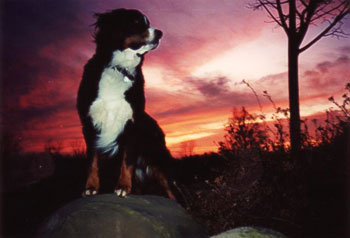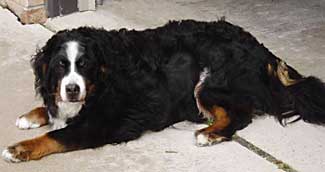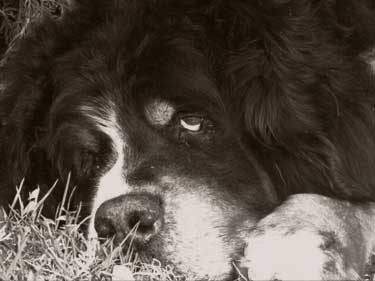Management of Common Musculoskeletal and Neurological Problems in Senior Dogs
By Toby Erlichman, VMD, and Carol Lundquist, DVM
 Aging Bernese Mountain Dogs, just as any aging large-breed dog, may be faced with one or more conditions that may affect their ability to get around comfortably in their environment. Often these issues are musculoskeletal, such as arthritis, or neurologic, such as lumbosacral stenosis, but may also be the result of a combination of these two closely related systems. Pain is often associated with these conditions, further limiting what the dog may be capable of doing. In this article we discuss various treatment modalities and the interplay of these modalities as well as techniques possibly to prevent these conditions from worsening.
Aging Bernese Mountain Dogs, just as any aging large-breed dog, may be faced with one or more conditions that may affect their ability to get around comfortably in their environment. Often these issues are musculoskeletal, such as arthritis, or neurologic, such as lumbosacral stenosis, but may also be the result of a combination of these two closely related systems. Pain is often associated with these conditions, further limiting what the dog may be capable of doing. In this article we discuss various treatment modalities and the interplay of these modalities as well as techniques possibly to prevent these conditions from worsening.
When we have an affected senior dog, it is important to make the distinction between a musculoskeletal problem and a neurologic problem, as this will help define what treatment modalities will bring the best success. The goals of treatment should include controlling inflammation (and subsequent pain), increasing range-of-motion, increasing flexibility and proprioception (awareness of the position of one's body), and strength training.
We have all experienced pain, whether it is post-operative, trauma-related, or degenerative, such as arthritis. It is not so easy to get into rehabilitation when there is pain, so this is certainly something that needs to be addressed early on in our senior Berners. There are many oral medications, herbs and supplements that may be given alone or in combination to control pain and inflammation, ranging from Non-Steroidal Anti-inflammatories (NSAIDs, such as Rimadyl, Deramaxx, Previcox, Metacam and Aspirin), to steroids, to analgesics (Tra-madol, Amantidine, Gabapentin, Codeine and morphine-like drugs), to anti-inflammatory herbs (white willow, feverfew, turmeric, boswellia, celery seed, cayenne and devil's claw), to enzymes such as bromelain and papain that may help to "digest" inflammation. These oral forms of treatment could be used for painful conditions such as arthritis, chronic Lyme disease, trauma, chronic muscle pain, and some neurologic disorders such as intervertebral disc disease and lumbosacral stenosis, among others. Injections of Cortisone and Legend® (hyaluronic acid) directly into joints may also help manage pain and inflammation. Legend® is an equine product that may also be given intravenously. Physical modalities such as acupuncture (with or without injecting into trigger points), reiki, laser and microcurrent are also excellent at controlling inflammation and pain. TENS (Transcutaneous Electrical Nerve Stimulation) and NMES (Neuromuscular Electrical Stimulation) units are both used for chronic pain as well as muscle rehabilitation. Controlling pain will not only make the senior pet feel better, but it will make your job as the caretaker easier and more rewarding, motivating you to help them even more!
 While pain may be somewhat managed with the above-mentioned medications, often it is only putting a band-aid on the problem. Without addressing the specific systems involved and attempting to return them to some function, the pain management will be temporary, at best. Once inflammation is decreased, it is crucial to begin to increase flexibility, balance and range-of-motion, thus increasing strength, which by itself will help to keep pain and inflammation under control. Chiropractic techniques will reduce subluxations (incomplete or partial dislocation, as of a bone in a joint), therefore increasing range-of-motion and decreasing pain and inflammation. Underwater treadmills and swim therapy, when available, are excellent ways to increase propriocep-tion and strength. Along with that there are many at-home exercises that may be done using a physioball or theraball that will help with core and trunk strengthening, stretching and overall strength training. Sometimes simply getting a dog to walk over a bunch of poles, or over pillows or couch cushions, will aid in strengthening their proprioception. This would be helpful in dogs with Degenerative Myelopathy. There are several good DVDs by Debbie Cross Saunders and Chris Zink that describe these exercises. Certainly the adage "move it or lose it" applies here.
While pain may be somewhat managed with the above-mentioned medications, often it is only putting a band-aid on the problem. Without addressing the specific systems involved and attempting to return them to some function, the pain management will be temporary, at best. Once inflammation is decreased, it is crucial to begin to increase flexibility, balance and range-of-motion, thus increasing strength, which by itself will help to keep pain and inflammation under control. Chiropractic techniques will reduce subluxations (incomplete or partial dislocation, as of a bone in a joint), therefore increasing range-of-motion and decreasing pain and inflammation. Underwater treadmills and swim therapy, when available, are excellent ways to increase propriocep-tion and strength. Along with that there are many at-home exercises that may be done using a physioball or theraball that will help with core and trunk strengthening, stretching and overall strength training. Sometimes simply getting a dog to walk over a bunch of poles, or over pillows or couch cushions, will aid in strengthening their proprioception. This would be helpful in dogs with Degenerative Myelopathy. There are several good DVDs by Debbie Cross Saunders and Chris Zink that describe these exercises. Certainly the adage "move it or lose it" applies here.
 Supplements may be used alone or in combination, as well as with other modalities, in the prevention and management of musculoskeletal and neuromuscular diseases. Probably the most familiar and widely known group of these would be the chondroprotectants. These help nourish joint spaces, keeping them fluid, as well as helping to decrease inflammation locally, therefore preserving joint integrity. Examples would be glucosamine and chondroitin (Cosequin® and Dasuquin®), pernna muscle, Adequan® (Polysulfated glycosaminoglycans) and hyaluronic acid. These may be started in Berners early in puppyhood, although some advocate waiting until growth is complete. They are readily available, very safe and well tolerated. Fish oils, or omega 3 and 6 fatty acids, are also commonly used in patients with musculoskeletal and neurologic disease, as they have good anti-inflammatory properties and are easily administered. Antioxidants are also widely used for both musculoskeletal disease and neurological disease. Green tea, a common antioxidant, is given in capsule form, while others used may include coQ10, pycnogenol, n-acetyl-cysteine, alpha lipoic acid and broccoli seed extract. Nutritional supplements such as MSM (often in combination with glucosamine and chondroitin), magnesium (used to relax tense muscles), malic acid and vitamin C may be used; silica promotes tendon strength and cetyl M may be used in cases of severe arthritis.
Supplements may be used alone or in combination, as well as with other modalities, in the prevention and management of musculoskeletal and neuromuscular diseases. Probably the most familiar and widely known group of these would be the chondroprotectants. These help nourish joint spaces, keeping them fluid, as well as helping to decrease inflammation locally, therefore preserving joint integrity. Examples would be glucosamine and chondroitin (Cosequin® and Dasuquin®), pernna muscle, Adequan® (Polysulfated glycosaminoglycans) and hyaluronic acid. These may be started in Berners early in puppyhood, although some advocate waiting until growth is complete. They are readily available, very safe and well tolerated. Fish oils, or omega 3 and 6 fatty acids, are also commonly used in patients with musculoskeletal and neurologic disease, as they have good anti-inflammatory properties and are easily administered. Antioxidants are also widely used for both musculoskeletal disease and neurological disease. Green tea, a common antioxidant, is given in capsule form, while others used may include coQ10, pycnogenol, n-acetyl-cysteine, alpha lipoic acid and broccoli seed extract. Nutritional supplements such as MSM (often in combination with glucosamine and chondroitin), magnesium (used to relax tense muscles), malic acid and vitamin C may be used; silica promotes tendon strength and cetyl M may be used in cases of severe arthritis.
Keeping your senior dog's environment as safe as possible is an often overlooked aspect of management. Obviously care should be taken with steps, slippery floors and jumping on furniture. Some senior dogs may benefit from the use of various braces, slings and ultimately carts, if the loss of function is severe. Boots may allow an unstable patient to gain traction on slippery surfaces and have increased mobility as a result. Specially fitted neoprene braces may help to stabilize an unstable joint, allowing for increased comfort and movement.
While this is by no means an exhaustive list, it introduces the idea that there are many treatment options available to keep our senior Berners comfortable and moving about. Controlling pain and inflammation by itself is not enough for long-term management. A treatment plan should also include appropriate strength training, proprioception, balance and range-of-motion work. Musculoskeletal and neurologic disease may exist together or by themselves, and combinations of traditional and alternative therapies may be used to treat them.

On Bernese Mountain Dog Health - Second of Three-Part Series
Authors: Toby Erlichman, VMD, and Carol Lundquist, DVM
► part 1 - | - part 3